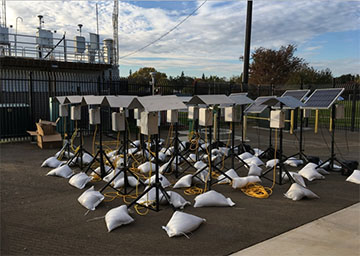Comparing Air Toxics and Wood Smoke Pollution Levels Across Sacramento EJ and Non-EJ Communities
Clients
Sacramento Metropolitan Air Quality Management District (SMAQMD)
To better understand how hazardous air pollutants (HAPs) impact Environmental Justice (EJ) and non-EJ communities in Sacramento, California, SMAQMD retained Sonoma Technology to design and conduct an air quality monitoring campaign. The goal was to explain the concentrations of HAPs throughout Sacramento, how smoke from residential wood-burning contributes to air pollution, and if EJ communities are disproportionately impacted by this pollution. Sonoma Technology scientists published the results of this study in <a href="https://doi.org/10.3390/ijerph17031080" target="new"><i>The International Journal of Environmental Research and Public Health.</i></a href>
<br>
This project was designed to help SMAQMD’s air quality outreach program reduce HAPs throughout Sacramento and especially in EJ areas. To meet this goal, Sonoma Technology conducted an intensive measurement campaign in the winter 2016-17 season and monitored HAPs, wood smoke markers, and black carbon. Sonoma Technology analyzed the collected data to quantify the inter-community variation of air pollutant concentrations and better understand the relationship of these pollutants to wood burning behavior. To understand the relationship between HAPs and particulate matter (PM), Sonoma Technology deployed low-cost sensors to measure PM in EJ and non-EJ communities, and assessed how these sensors compared to traditional monitors.
<br>
The study found that concentrations of HAPs and black carbon released by fossil fuels were higher in the EJ communities, while concentrations of black carbon released by wood burning was significantly higher in the non-EJ communities. Correlation analysis indicated that the concentrations of HAPs in the EJ communities were predominantly from fossil fuel sources and not from wood burning, indicating that mobile source emissions were likely higher in the EJ communities.
<br>
This project was designed to help SMAQMD’s air quality outreach program reduce HAPs throughout Sacramento and especially in EJ areas. To meet this goal, Sonoma Technology conducted an intensive measurement campaign in the winter 2016-17 season and monitored HAPs, wood smoke markers, and black carbon. Sonoma Technology analyzed the collected data to quantify the inter-community variation of air pollutant concentrations and better understand the relationship of these pollutants to wood burning behavior. To understand the relationship between HAPs and particulate matter (PM), Sonoma Technology deployed low-cost sensors to measure PM in EJ and non-EJ communities, and assessed how these sensors compared to traditional monitors.
<br>
The study found that concentrations of HAPs and black carbon released by fossil fuels were higher in the EJ communities, while concentrations of black carbon released by wood burning was significantly higher in the non-EJ communities. Correlation analysis indicated that the concentrations of HAPs in the EJ communities were predominantly from fossil fuel sources and not from wood burning, indicating that mobile source emissions were likely higher in the EJ communities.
Air Quality
Community Monitoring
Emissions
Environmental Justice
Exposure
Health
Instruments
Low-Cost Sensors
Measurements
Modeling
Policy and Planning
Public Outreach


Steve G. Brown

Steve
G.
Brown
Northern California Regional Director / Senior Atmospheric Scientist
sbrown@sonomatech.com
/sites/default/files/2023-07/SGBres.pdf
